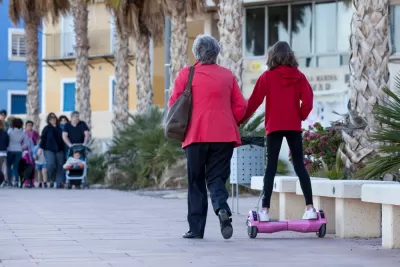More people live in multi-generational homes than ever, according to analysis of Census data by the Pew Research Center.

Audrey Hoffer reports on an increasing trend in the housing market: more people living in multi-generational homes (defined as households including grandparents and grandchildren, or two or more generations of adults. Hoffer cites analysis by the Pew Research Center that uses Census data.
"In 2009, the last year of the Great Recession, 17 percent of Americans lived in households that were multigenerational," explains Hoffer. "This translates to 51.5 million people living in homes with either grandparents and grandchildren, or with two or more adult generations."
Fast forward a few years, and that number has grown, according to Hoffer. "In 2016, the most recent Pew numbers, 20 percent of Americans — 64 million people — lived in multigenerational homes."
"This is a record number of people," says D’Vera Cohn, a senior writer and editor at Pew, as quoted in the article.
The multi-generational household trend opens several angles for Hoffer's coverage. There's the anecdotal experience of living in a multi-generational home, along with the development market that has opened in response to the demand for multi-generation living arrangements.
"Builders are adapting their home designs to create additional living spaces that offer privacy and separation for parents or college students moving back home, and ground floor suites for easy access for grandparents," says Kim Adams, director of marketing for the Brambleton Group, as quoted in the article.
Sources on both sides of the market expect the trend to continue.
FULL STORY: Homes with multigenerational family members are a growing trend

Maui's Vacation Rental Debate Turns Ugly
Verbal attacks, misinformation campaigns and fistfights plague a high-stakes debate to convert thousands of vacation rentals into long-term housing.

Planetizen Federal Action Tracker
A weekly monitor of how Trump’s orders and actions are impacting planners and planning in America.

In Urban Planning, AI Prompting Could be the New Design Thinking
Creativity has long been key to great urban design. What if we see AI as our new creative partner?

King County Supportive Housing Program Offers Hope for Unhoused Residents
The county is taking a ‘Housing First’ approach that prioritizes getting people into housing, then offering wraparound supportive services.

Researchers Use AI to Get Clearer Picture of US Housing
Analysts are using artificial intelligence to supercharge their research by allowing them to comb through data faster. Though these AI tools can be error prone, they save time and housing researchers are optimistic about the future.

Making Shared Micromobility More Inclusive
Cities and shared mobility system operators can do more to include people with disabilities in planning and operations, per a new report.
Urban Design for Planners 1: Software Tools
This six-course series explores essential urban design concepts using open source software and equips planners with the tools they need to participate fully in the urban design process.
Planning for Universal Design
Learn the tools for implementing Universal Design in planning regulations.
planning NEXT
Appalachian Highlands Housing Partners
Mpact (founded as Rail~Volution)
City of Camden Redevelopment Agency
City of Astoria
City of Portland
City of Laramie





























